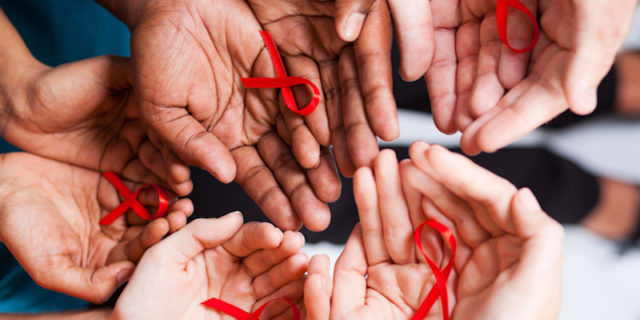
World AIDS Day is an annual campaign that has been happening since December 1, 1988. It was started not only to honor and remember those we lost to HIV/AIDS, but also to show support for those who are living and HIV-positive while at the same time spreading awareness about HIV/AIDS. It’s reported that in 2016, 36.7 million people were living with HIV and 19.5 million of those people were accessing antiretroviral therapy. While that access to life-changing medication is so valuable, we still lost 1 million people to an AIDS-related illness last year.
That is far too many.
While we need to attend to the candlelight vigils this year to honor those we’ve lost to AIDS, it’s also important to continue to advocate and educate about treatment and prevention. The 2018 World AIDS Day campaign is all about #KnowYourStatus. Get tested. And remove the barriers to getting tested.
“We are not dirty, we are not a threat, and we are not disease vectors. In fact, we are the solution. People living with HIV who achieve viral suppression, who become undetectable, are the solution to the end of new HIV infections in the United States… When we look back 20 years from now we’re going to judge ourselves in terms of how well we responded to this opportunity.”
Here are five ways you can make an impact to end HIV/AIDS and all the stigma that comes with it.
1. Get Tested and Know Your Status
Everyone who is sexually active should get tested. And regularly. On World AIDS Day, there are often free testing spaces set up all around major U.S. cities. But don’t just rely on this one day per year. The CDC recommends an HIV and STI test every 3 months. Knowing your status is empowering, it allows you to make the best sexual decisions for yourself and your partners.
Even if you use protection, still get tested. Most HIV-positive people don’t know they are positive, so even if your partner says they’re negative—you still want to get that test, babes. According to the CDC, 1 in 7 Americans living with HIV doesn’t know it yet. Which is a huge part of the problem. When HIV goes untreated, it has far worse implications for the person living with HIV, and their sexual partners who think they aren’t at risk. Being positive is no longer a death sentence. But getting tested regularly is the first step keeping that statement true.
2. Fight Stigma
Even though a lot of the misinformation about HIV and AIDS has been proven incorrect by scientists and doctors alike, there is still so much stigma. Remember when Princess Diana hugged an HIV-positive child and made headlines in the ’80s? A lot of people thought that she would contract the illness from that hug. That’s why we need to resist against this stigma.
You could look into volunteering at a local community agency that supports people living with HIV. You can talk about getting tested with your friends and family. You can share awareness videos on your social media. You can advocate for PEP and PrEP. You can call someone out (and educate them!) when they shame someone for being positive.
3. Talk About Treatment and Prevention
I’m usually not one to advocate for big-pharma because I think they are trying to profit off of us, like, ~constantly~. But there are actually amazing, lifesaving options out there to help prevent and treat HIV. PrEP is a pre-exposure prophylaxis, which acts like a preventative medicine an HIV-negative person can take every day to reduce their risk of an HIV infection. PrEP should be taken at least 7 days to reach optimal levels of protection against HIV. PEP is a post-exposure prophylaxis which can be taken up 72 hours after a possible exposure to HIV. But one-third of America’s primary care doctors and nurses have never even heard of Truvada. All the more reason to talk about it.
There’s also antiretroviral therapy (or ART) for people who are positive. When people who are positive say they are undetectable, this is why. They have a treatment plan and are sticking to it. In fact, scientists have found that undetectable effectively means untransmittable. If you’re a numbers person, there’s this PARTNER Study that recorded over 58,000 acts of penetrative sex without condoms between 1,000 positive/negative couples, where the HIV partner had an undetectable viral load. There were no infections between the couples. NONE.
4. Get The Facts
So many people still think that HIV can be transmitted via kissing (it can’t). Ignorance and a lack of proper sex education spreads HIV, not a make-out session. There’s also a lot of misunderstanding and judgment for HIV-positive people who give birth. The reality is that 99.5 percent of children born to HIV-positive parents are born free of the infection. It’s also important to know that HIV doesn’t necessarily mean AIDS is a certainty. With a proper treatment plan, the majority of HIV-positive people will never get AIDS. There’s also an assumption that gay men are the only demographic at risk for HIV. Wrong! In fact, the fastest growing group of people living with HIV are people over 50 years old. And yes, lesbians can contract and share HIV with their sexual partners.
There’s a lot of misinformation out there. Get the facts and spread that knowledge, babes!
5. Spread Awareness
This can come in the form of a tweet, a text, a phone call, or a sit-down conversation. Wear a red ribbon on Saturday and when people ask you why, engage in a meaningful conversation using some of the information you learned in this article. Invite your friends or partners along with you to get tested. Write a post on social media using the hashtags #WAD2018 and #KnowYourStatus. Or share this article on your newsfeed!

What Do You Think?